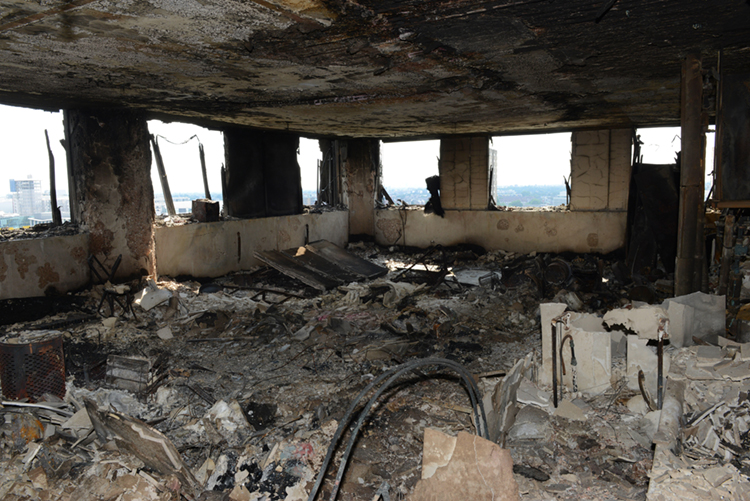The Grenfell Tower burns out of control as firefighters hose the building’s lower floors early on June 14, 2017, in London, England. Credit: Natalie Oxford (licensed under C BY 4.0)
Last month, on June 14, a fire destroyed much of Grenfell Tower, a 24-story apartment building in London, England. The fire, which took place in the city’s Kensington district, killed at least 80 people—the deadliest fire in London since World War II (1939-1945). The tragedy devastated many families and brought harsh criticism on local and national government as well as London’s fire safety laws and emergency response management.
The Grenfell fire started around midnight in a malfunctioning refrigerator freezer on the building’s fourth floor. That small fire ignited the building’s exterior cladding, a protective layer on the outside of the building’s structure. In this case, the cladding consisted of aluminumplates with a polyethylene core and polyisocyanurate insulation. Polyethylene and polyisocyanurate are types of plastic. The flammable cladding accelerated the fire, which quickly engulfed the building’s upper stories. The cladding—which also released deadly cyanide fumes—was blamed for the fire’s rapid outside-in path that trapped so many people, leading to the terrible death toll (people died from cyanide fumes as well as from flames and smoke). The fire burned intensely for many hours, and was not completely extinguished until June 16.
Some 250 firefighters responded to the Grenfell Tower fire, and they were credited with rescuing 65 people. Riot police worked alongside the firefighters, using their shields to protect firefighters from cascades of burning debris. Other police helped firefighters break down doors into locked apartments. Many people remained trapped in the building, however, as intense heat, flames, smoke, and toxic fumes continually forced rescuers to slow or alter their advance. Eighty people are known to have died in the fire. However, full analysis of remains will not be completed for some time, and the death toll is likely to rise.

This photo shows a devastated corner apartment in the burned-out Grenfell Tower on June 18, 2017. Credit: London Metropolitan Police
Grenfelll Tower was constructed in 1974. It had 129 apartments and space for some 600 residents. Grenfell had just one entrance and one staircase, and residents often complained that this could be a problem in an emergency evacuation. British regulations, however, require just one staircase in a building of that size, unlike rules in most countries that require two. Residents also complained of exposed natural gas pipes in the building, and the installation of fire-retardant boxing around the pipes had begun but was not yet completed at the time of the fire. (Several gas lines burst during the fire, which worsened the situation.)
In 2015 and 2016, Grenfell Tower—which also lacked a sprinkler system—was renovated and the new cladding was added to improve the tower’s exterior appearance. Fireproof zinc cladding was passed over in favor of much cheaper aluminum cladding. After the fire, the cladding used at Grenfell—which has long been banned on high-rise buildings in the United States and other countries—failed fire safety tests. The cladding was then banned in the United Kingdom and is in the process of being removed and replaced in hundreds of buildings throughout the country.
The local Kensington council was blamed for ignoring safety complaints from Grenfell, which was populated by largely poor, immigrant, and ethnic-minority tenants in an otherwise affluent area. The British government was blamed for deregulating the building industry and for cutting funding for fire prevention, as well as for its slow response in helping survivors of the fire. A public inquiry into the fire is scheduled to begin in September.
Untitled Document Can't view the linked articles? Subscribe to World Book Online

World Book Online delivers a progressive sequence of core databases supported by supplemental
tools, such as language translation, graphic organizers, and unique Webquests. Moving from
Early World of Learning to World Book Advanced, World Book Online aligns end-users with their
appropriate learning levels. Each stand-alone site provides additional features to support the
needs of users’ specific capabilities.
The World Book Difference
World Book combines cutting-edge technology with traditional editorial excellence to produce
authoritative, trustworthy, and unbiased content. The digital content is updated in real time and
carefully curated for each learning level. Accessible 24/7, the content is available on a variety of devices.
World Book Online combines 21st-century instructional techniques with timely information.
By breaking down complex topics and using easily understandable text, World Book Online helps to
build fluency and increase comprehension. Featuring single sign-on capability, these sites are paired
with highly visual content to engage even the most reluctant reader. Our collection of resources kindles
a lifelong learning experience for every user. This adherence to clarity, currency, and accuracy makes
World Book’s digital offerings an information hub for the classroom, library, and beyond.
|